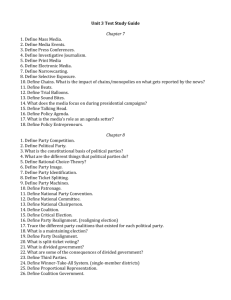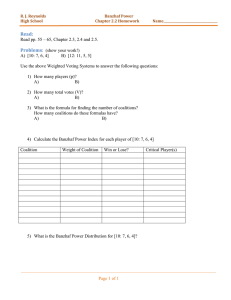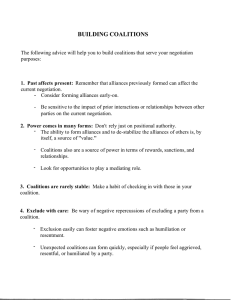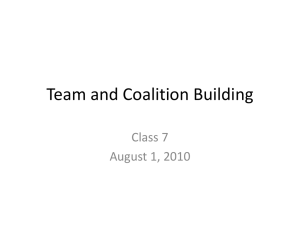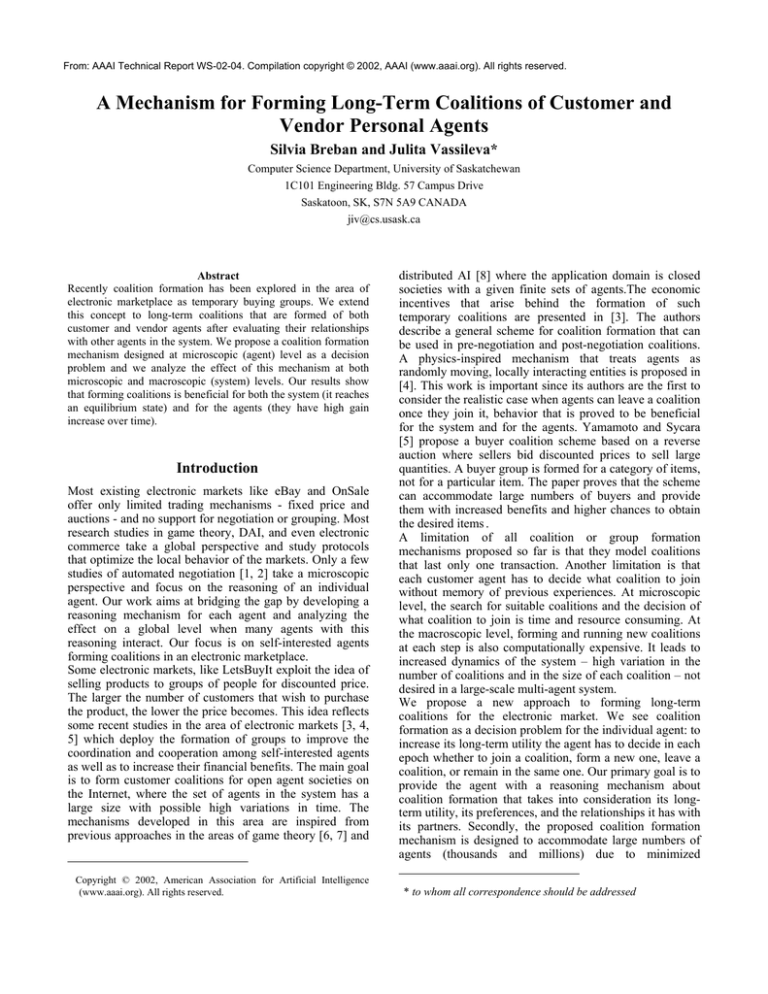
From: AAAI Technical Report WS-02-04. Compilation copyright © 2002, AAAI (www.aaai.org). All rights reserved.
A Mechanism for Forming Long-Term Coalitions of Customer and
Vendor Personal Agents
Silvia Breban and Julita Vassileva*
Computer Science Department, University of Saskatchewan
1C101 Engineering Bldg. 57 Campus Drive
Saskatoon, SK, S7N 5A9 CANADA
jiv@cs.usask.ca
Abstract
Recently coalition formation has been explored in the area of
electronic marketplace as temporary buying groups. We extend
this concept to long-term coalitions that are formed of both
customer and vendor agents after evaluating their relationships
with other agents in the system. We propose a coalition formation
mechanism designed at microscopic (agent) level as a decision
problem and we analyze the effect of this mechanism at both
microscopic and macroscopic (system) levels. Our results show
that forming coalitions is beneficial for both the system (it reaches
an equilibrium state) and for the agents (they have high gain
increase over time).
Introduction
Most existing electronic markets like eBay and OnSale
offer only limited trading mechanisms - fixed price and
auctions - and no support for negotiation or grouping. Most
research studies in game theory, DAI, and even electronic
commerce take a global perspective and study protocols
that optimize the local behavior of the markets. Only a few
studies of automated negotiation [1, 2] take a microscopic
perspective and focus on the reasoning of an individual
agent. Our work aims at bridging the gap by developing a
reasoning mechanism for each agent and analyzing the
effect on a global level when many agents with this
reasoning interact. Our focus is on self-interested agents
forming coalitions in an electronic marketplace.
Some electronic markets, like LetsBuyIt exploit the idea of
selling products to groups of people for discounted price.
The larger the number of customers that wish to purchase
the product, the lower the price becomes. This idea reflects
some recent studies in the area of electronic markets [3, 4,
5] which deploy the formation of groups to improve the
coordination and cooperation among self-interested agents
as well as to increase their financial benefits. The main goal
is to form customer coalitions for open agent societies on
the Internet, where the set of agents in the system has a
large size with possible high variations in time. The
mechanisms developed in this area are inspired from
previous approaches in the areas of game theory [6, 7] and
Copyright © 2002, American Association for Artificial Intelligence
(www.aaai.org). All rights reserved.
distributed AI [8] where the application domain is closed
societies with a given finite sets of agents.The economic
incentives that arise behind the formation of such
temporary coalitions are presented in [3]. The authors
describe a general scheme for coalition formation that can
be used in pre-negotiation and post-negotiation coalitions.
A physics-inspired mechanism that treats agents as
randomly moving, locally interacting entities is proposed in
[4]. This work is important since its authors are the first to
consider the realistic case when agents can leave a coalition
once they join it, behavior that is proved to be beneficial
for the system and for the agents. Yamamoto and Sycara
[5] propose a buyer coalition scheme based on a reverse
auction where sellers bid discounted prices to sell large
quantities. A buyer group is formed for a category of items,
not for a particular item. The paper proves that the scheme
can accommodate large numbers of buyers and provide
them with increased benefits and higher chances to obtain
the desired items .
A limitation of all coalition or group formation
mechanisms proposed so far is that they model coalitions
that last only one transaction. Another limitation is that
each customer agent has to decide what coalition to join
without memory of previous experiences. At microscopic
level, the search for suitable coalitions and the decision of
what coalition to join is time and resource consuming. At
the macroscopic level, forming and running new coalitions
at each step is also computationally expensive. It leads to
increased dynamics of the system – high variation in the
number of coalitions and in the size of each coalition – not
desired in a large-scale multi-agent system.
We propose a new approach to forming long-term
coalitions for the electronic market. We see coalition
formation as a decision problem for the individual agent: to
increase its long-term utility the agent has to decide in each
epoch whether to join a coalition, form a new one, leave a
coalition, or remain in the same one. Our primary goal is to
provide the agent with a reasoning mechanism about
coalition formation that takes into consideration its longterm utility, its preferences, and the relationships it has with
its partners. Secondly, the proposed coalition formation
mechanism is designed to accommodate large numbers of
agents (thousands and millions) due to minimized
* to whom all correspondence should be addressed
communication between agents and reduced complexity.
Finally, for system stability and predictability reasons our
approach has two more objectives: to reduce the dynamics
of the agents (i.e. their movement between coalitions) and
to stabilize the number of coalitions in the system.
Long-Term Coalitions
Customer 1
Customer 2
Customer n
one shot
Large Qty
Vendor
Vendor
A)
Large Qty (Discount)
We address an electronic market composed of personal
agents representing human users. They have fixed roles of
either customer or vendor. They trade the same class of
goods (e.g. books) on the Internet and use the same
reasoning mechanism. We allow the agents to form
coalitions to increase their individual benefits. A coalition
also has the benefit of providing a smaller and more
familiar environment that reduces search time in the
routine interactions between agents. Hopefully, in this way
coalitions will help to improve the efficiency of the market.
In the design of the proposed coalition formation
mechanism we make the following assumptions:
Agents have individual rationality. They try at any time
to maximize their own long-term utility. A vendors’
utility is represented by its sales over time. A
customer’s utility consists of the amount gained from
discounted transactions.
Agents have a long lifetime of repeated interactions
with other agents in the system and no interdiction to
interact with agents outside of their coalition.
Agents may have different interests in the goods that
being traded (e.g. science fiction, romance, history
books). Agents may belong to different economic
categories (e.g. a customer that affords to buy books
between $20 and $60 and a vendor that sells only for
more than $100 belong to different categories and can
never engage in successful trade).
Coalitions may have a long lifetime once created. They
are disjoint, i.e. one agent cannot belong to two
coalitions at the same time. While this assumption
seems quite restrictive it is not unrealistic, assuming
that a coalition reflects a range of agent interests and
goods that can be traded. In our future research we will
relax this condition.
A coalition is created when an agent wants to form a
new coalition with another agent. The latter always
agrees, since there is no cost for joining a coalition.
This may seem as unrealistic assumption too, if we
consider real people. However, we are talking about
software agents that follow a particular protocol defined
here. A coalition dissolves when composed of only one
agent.
An agent can join or leave a coalition at any moment.
However, a penalty might have to be paid by agents
leaving a coalition. This reflects the costs that a vendor
agent has to incur by loosing his clientele, and the
higher search costs a client has to pay to find suitable
agents for trading in a new coalition.
Agents in the same coalition receive a specific fixed
discount for each transaction executed. Thus the agents
prefer to be part of the coalition with the agents with
whom they expect to have most frequent transactions
future.
The coalition structure (the partition of agents into
coalitions) is global knowledge. This is also an
assumption that does not seem realistic in real-life
markets. However, in a market formed by agents
following the described protocol, this can be achieved.
A vendor agent enters a coalition to increase its sales. It
prefers to be part of the same coalition as customer agents
with whom it has most transactions and it agrees with a
certain discount for each transaction inside its coalition.
Figure 1 presents the idea visually: instead of selling in
bulk at one moment to several customers, as proposed in
previous approaches on coalition formation, the vendor
uses a policy that leads to selling a large quantity to the
same customer after repeated transactions at different
times.
Thus a vendor joins coalitions to get closer to customers
that have compatible preferences, and thus to nurture
vendor-customer relationships. The concept is similar to
the established practice in real-life markets like Safeway or
Sears that give a minimal discount to members of their
clubs. This policy known in economics as Customer
Relationship Management (CRM) [9] and is motivated by
the fact that establishing a friendly and trustworthy
relationship with clients promises vendors more
transactions for the long run and retention of customers.
Customer i
Customer i
time
Customer i
B)
Figure 1: Discounted transactions for:
A) all customers in a one-transaction coalition;
B) one customer in a long-term coalition at different times.
The advantage for customers of being members of longterm coalitions in this approach is that they are sure to get a
discount at any time, while in previous approaches the
discount depends entirely on finding other agents interested
in the same product at the same time, agreeing to buy the
necessary amount of goods, and successfully negotiating
with vendors.
The Decision Problem
From the point of view of a decision-making agent with
finite computational resources, it makes sense to view the
coalition formation as a problem of decision making in the
face of uncertainty. An agent must decide at each epoch
whether or not a change its coalition according to its best
interests. It may choose to form a new coalition, to join an
existing coalition (possibly by leaving an existing coalition
first), to leave a coalition (and remain independent), or,
finally, to remain in its current coalition.
An agent is assumed to know the current coalition structure
with certainty before having to take any action. As well,
the agent has memory of previous interactions with other
agents. However, the agent does not know how the other
agents will act in the current epoch. There are basically
three options. First, the agent could consider all possible
actions of all other agents, and try to determine a suitable
steady state; this we discard, since we assume that the agent
cannot determine this state with the computational
resources available to it. Second, our agent could treat the
behavior of other agents as stochastic, by providing a
probability distribution over possible coalition structures in
the next epoch. However, there are too many possible
coalition structures to consider by enumeration. Third, the
agent can assume that the coalition structure will remain
static, except for the action it takes. For rationally bounded
agents this approach has some psychological relevance and
is feasible. The agent’s action directly affects the newly
formed coalition structure, and this affects the agent’s
utility. The new coalition structure is different form the old
one only regarding the current agent. Also the agent does
not know with what coalition it will have most transactions
in the future – that depends on the new coalition structure.
If we represent the decision problem about coalition
formation that the agent faces as an influence diagram the
solution can be found by maximizing the agent’s utility; the
action associated with the maximum utility is the most
beneficial for the agent.
To directly solve the agent decision problem about
coalition formation using an influence diagram would
involve expensive computation since a couple of choice
nodes may vary over all possible coalition structures. As
mentioned by Sandholm et al. [10] the total space of
enumerating (or searching) possible coalition structures is
exponentially proportional with the number of agents in the
system.
Therefore, we decided to use an intermediate utility
function that depends on the past transactions of the agent
and on its future expectations. This function characterizes
each coalition from the coalition structure. It reflects the
agent’s opinion about having common interests and
preferences with agents from that coalition that would
promise increased profit within the coalition. We name this
utility function the agent’s relationship with a coalition.
The strength of this relationship reflects the agent’s
expectation to have fruitful future transactions within the
coalition. When the agent knows the strengths of all its
relationships with existing coalitions it can solve its
decision problem by finding and joining the coalition with
which it is most strongly related. For this the agent
maintains a simplified model of its past experience with
any other agent in the system that we call inter-agent
relationship. When the agent needs to decide which
coalition is most profitable it calculates its relationship with
each coalition as a function of its inter-agent relationships
with agents from the coalition. We present two different
definitions of this function in section 4.
We represent the strength of inter-agent relationships using
the trust model proposed by Jonker and Treur in [11].
Given a set of experience classes E and a set of predefined
inter-agent relationship strength quantifications S, a
mapping for the transition from one strength value s to
another strength(e, s) can be defined as:
strength : E × S S
strength (e, s) = (1 – d) * e + d * s
We consider the case in which an experience can take any
value in the interval E = [-1, 1]. If an experience e is
evaluated as a positive one it is assigned a positive value
from E+; if e is a negative experience it takes a negative
value (from E-). We consider the set of predefined strength
quantifications S = [-1, 1]. The parameter d ∈ [0, 1] is an
inflation rate used to model the fact that older experiences
become less important over time, while the most recent
experience is the most relevant (since the agent preferences
may change in time). In this function after each new
experience e, the existing strength of the relationship s is
multiplied by d and the impact of the new experience e is
added, normalized so that the result fits in the desired
interval S.
Based on this representation and on the set of discrete time
values when experiences take place Time = Ν+ (the set of
natural numbers), a evolution function evol is inductively
defined in [11]. This function is used by the agent when it
has to update its relationship in another agent at each step
from the Time set:
evol : E × Time S
evol (e, 0) = 0
evol (e0e1 … ei, i+1) = strength (ei,evol ( e0e1 … ei -1, i ))
The definition of the evolution of inter-agent relationship
strength specifies that the initial strength for step 0 is set to
a neutral value 0. At each step i+1 the strength is updated
based on the previous value (from step i) and the current
experience ei according to the strength function defined
above. We use this formal model to represent inter-agent
relationships.
Coalition Formation Mechanism
Scenario
We consider a system of multiple agents trading books on
behalf of their users in an open electronic market. Before a
transaction between a customer and a vendor is executed,
the two agents go through a bilateral negotiation phase to
agree on a certain price using a previously developed
negotiation mechanism [1]. The negotiation consists of an
iterative process in which the two agents make offers and
counteroffers based on the preferences of their users and on
the reply of their opponent. The agents negotiate according
to preferences set up by their users, which define the
minimum acceptable price for vendors and the maximum
affordable price for customers, the subjective importance
that money has for the users, the urgency of the current
goal of selling or purchasing a certain product, the riskattitude, and the time constraints for executing the current
transaction [1]. These preferences play a crucial role in the
result of the negotiation and influence the compatibility or
incompatibility between the agents (and correspondingly,
between their users). Therefore, negotiations that result in
failure are interpreted by the agent as negative experience.
If the negotiation has completed with success, the actual
transaction is executed, and the result is evaluated by the
user. This evaluation may include many factors, e.g. if the
good was delivered in time, whether the quality was
acceptable, if the payment was received in time, etc. The
user then informs his/her agent, about the final result of the
evaluation, if it was unsuccessful or successful transaction.
The agent interprets this information is negative or positive
experience, correspondingly. Positive experiences are
assigned values from the positive subset of experience
classes E+ while negative experiences are evaluated in the
negative subset of experience classes E- (see Figure 2).
COALITION FORMATION MECHANISM
INTERACTION
rejection
NEGOTIATION
agreement
APPLY DISCOUNT
EVALUATE
EXPERIENCE
EVALUATE
EXPERIENCE
E-
UPDATE STRENGTH
E+
COALITION REASONING MECHANISM
DECISION MAKING
REMAIN IN THE
SAME STATUS
FORM A NEW
COALITION
relationships with all agents in the system with whom it has
ever interacted. The agent’s relationships with the other
agents have a strength of null. An agent represents the
relationship with another agent by a tuple, consisting of the
other agent’s name and a relationship strength value from
S.
Each change in the representation of the agent’s
relationships triggers the coalition reasoning mechanism
shown in Figure 2. The agent makes use of its relationships
with individual agents to calculate its relationships with the
currently existing coalitions in the system. The agent’s
relationship with a specific coalition is calculated as a
function of the agent’s relationships with the individual
agents from that coalition. There are many possible ways to
define this function. We implemented and evaluated two
different ones. The first function (called soc1 strategy)
defines the strength of an agent’s relationship with a
coalition by calculating the sum of the strength of the interagent relationships that the agent has with the agents from
that coalition. The second one (called soc2 strategy) simply
computes the number of all agents in the coalition with
whom the agent has positive relationships. Interestingly,
our experiments showed that though these two functions
appear to be similar, they lead to different macro- and
microscopic results.
LEAVE CURRENT
AND JOIN NEW
Figure 2: The coalition formation mechanism.
For the purposes of our experiment, we limited the scope of
evidence for the strength of the relationship to the outcome
of the negotiation between the agents, because modeling
the actual transaction involving payment and delivery of
goods with variable quality in the simulation would have
added complexity that would have made it hard to interpret
the results of the experiment. In addition, it wound not
have contributed to the evaluation of the coalition
formation mechanism. So for the purpose of evaluating this
coalition mechanism, we assume that once a negotiation
between agents has resulted in success, the goods were
always delivered in time and were of satisfactory quality.
Note, however, is not a limitation to the mechanism per se,
but just a simplification for the purpose of evaluation.
When the new experience is evaluated, the strength of the
relationship that the two agents have in each other is
updated according to the evolution function defined in the
previous section. Each agent stores a representation of its
Microscopic Description
To express formally the problem, let us assume that the
multi-agent system consists of n agents that form at the
current moment m coalitions. A coalition is identified by a
label that is a number between 1 and m. We represent the
special case of an agent outside of coalitions as the agent
belonging to a special coalition with label 0. We assume as
global knowledge in the system the set of agents A = {A1,
A2, … , An } and the set of their corresponding coalitions C
= {C1, C2, …,Cn}, where Ci is the label of the coalition to
which Ai belongs (remember the assumption that each
agent can belong to only one coalition at a time). Agent Ai
has relationships with k agents (a subset of A) that we
represent as vector R(Ai ):
R(Ai ) = (Ai1, Ai2, .., Aik )
where Aij ∈ A \ { Ai } for 1 <= j <= k. We denote by S(Ai)
the corresponding vector of relationship-strengths that Ai
has in each of these agents:
S(Ai ) = (Si1, Si2, .., Sik )
where Sij is the strength of the relationship that Ai has with
Aij. Si1, Si2, .., Sik take values from the set of predefined
quantifications S. The corresponding coalitions of these k
agents form the set of coalitions C(Ai ):
C(Ai ) = (Ci1, Ci2, .., Cik )
where Cij is the label of the coalition to which Aij belongs.
The current coalition of Ai is denoted by Ci. Coalitions Ci,
Ci1, Ci2 ..., Cik have values of either 0 (if the agent is
outside of all coalitions) or between 1 and m (i.e. the
coalition label, if the agent is in a coalition).
As explained in the previous section, the agent knows the
coalition structure, since it is public knowledge. As a result
it knows the coalition it belongs to Ci and the coalitions
C(Ai), in which agents from R(Ai ) belong. It also knows the
strengths of its own relationships with other agents S(Ai).
Based on these, it calculates the strength of its relationships
in each coalition. The new vector is denoted by SC(Ai ):
SC(Ai ) = (SCi0, SCi1, .., SCim )
where SCij represents the strength of the relationship that Ai
has with coalition j. In the soc1 strategy the strength of the
relationship of agent i with coalition k is calculated as the
sum of the strength of relationships between agent i and the
agents in the coalition:
SCik = Σ j (Sij ),
where agent Aij is in coalition with label k (i.e. Cij = k), j
varies from 1 to | Cij |, and k varies from 1 to m. In the soc2
strategy the same relationship strength is defined as the
number of agents from the coalition with whom the agent
has relationships with positive strength, or:
SCik = | R’(Ai ) | ,
where R’(Ai ) is a subset of R(Ai ) defined as the set of
agents from coalition k with whom Ai has positive
relationships. An agent Aij is in R’(Ai ) if and only if Cij = k
and Sij >0. For both strategies we consider the special case
of agents that are outside of coalitions as being members of
coalition 0. The rule-based algorithm is the same for the
soc1 and soc2 strategies:
Build SC(Ai) - the vector of relationships in coalitions
Find coalition k with highest relationship strength
if (Ai in a coalition) AND (k is not the coalition of Ai)
Ai leaves its current coalition
if (k is not coalition 0) then
Ai joins coalition k
else
Ai forms a new coalition with the agent(s)
outside of coalitions with whom it has highest
relationships
We evaluate and compare the effect of the two agent
strategies (soc1 and soc2) in the next section.
Evaluation
We have developed a simulation prototype of the proposed
coalition formation mechanism in Java. We ran 18 sets of
experiments with different parameter configurations over
several platforms: Windows 2000, Windows NT, HP Unix,
Sun Solaris, and Linux. Each set of experiments consisted
of 100 trials over which the results were averaged.
Our goal was to evaluate the mechanism at macroscopic
and microscopic levels. For the first part we investigated
the number of coalitions in the system, the overall
dynamics, and how these factors evolve over time. The
evolution of the number of coalitions is relevant for reasons
of predictability while the system dynamics (calculated as
the sum of the number of coalitions visited by each agent)
is important in establishing whether the system reaches an
equilibrium state or not. For the microscopic evaluation we
focused on the individual gains of the customer agents
(calculated as the average of the sum of benefits obtained
from all discounted transactions by each customer). The
experiments were intended to compare the different agent
strategies described in the previous section (soc1 and soc2).
Some variables involved in the design of the mechanism
were set constant for all experiments: the inflation rate of
the relationship strength (d = 0.5), the evaluation of
positive experiences (0.2), the evaluation of negative
experiences (-0.2), and the discount rate (5% of the price).
The parameters under investigation are summarized in
Table 1.
# customers
# vendors
# interactions
agent strategy
# categories
100; 1000
100
1; 100; 1000; 10,000; 100,000;
soc1; soc2
1; 5; 10
Table 1: Simulation parameters and their values
Note that the number of vendor agents was set to 100, while the
number of customer agents was varied to 100 and 1000. A
significant parameter for the evolution of different factors over
time is the number of interactions between agents (each
corresponding to an epoch of the mechanism). Another simulation
parameter used in our evaluation was the number of categories of
agents. A category is meant to predefine the classes of interests
and preferred ranges of prices that are set up by the human users.
Vendor and customer agents from different categories never reach
an agreement since their preferred ranges of prices do not overlap.
Configuration
100V/
100C
100V /
1000C
1 ctg
5 ctg
10 ctg
1 ctg
5 ctg
10 ctg
Peak values
soc1
soc2
32
19
8
88
75
72
34
39
31
87
74
80
Lowest values
soc1
soc2
5
14
7
7
30
80
1
5
10
1
5
10
Table 2: Number of coalitions (peak and lowest values)
Configuration
100V/
100C
100V /
1000C
1 ctg
5 ctg
10 ctg
1 ctg
5 ctg
10 ctg
Dynamics
soc1
soc2
44
20
2
50
23
15
1
0
0
3
3
2
Agent Gains
soc1
soc2
3
1
1.2
0.2
0
0
13
2.6
1.3
1.3
0.2
0.1
Table 3: Highest dynamics and agent gains (in thousands)
We plot in Figure 3 the results that show the evolution of
the number of coalitions, system dynamics, and the
individual agent gain. Graphs A and D represent the
number of coalitions for different agent strategies: soc1 and
soc2; graphs B and E – the system dynamics for soc1 and
soc2; graphs C and F – the individual agent gain for soc1
and soc2. On the X-axis the number of interactions is
represented on a logarithmic scale from 1 to 1,000,000; the
Y-axis shows the investigated parameter.
points with 1 million interactions) in Table 3. We note that
for soc1 the values are higher and for soc2 they are lower.
.
A)
D)
B)
C)
E)
F)
Figure 3: A) Number of coalitions for soc1; B) System dynamics for soc1; C) Individual gain for soc1;
D) Number of coalitions for soc2; E) System dynamics for soc2; F) Individual gain for soc2.
The number of coalition, shown in Figures 3A and 3D,
ranges from 1 to 100. Our results show that as the number
of interactions among agents increases, the number of
coalitions first grows, it reaches a peak, and then it starts to
decrease. At the beginning the agents form coalitions and
after a while they start merging. We focus on analyzing the
peak values that reflect the formation of coalitions and the
lowest values (after 1 million interactions) that reflect the
merging rate of the coalitions. The difference between
these two values shows the speed of coalition merging.
Both the peak and the lowest values are shown in Table 2.
The number of coalitions has a predictable and controllable
evolution over time that depends on the number of vendors
(this is its higher limit); on the number of customers (it has
different merging behaviors for 100 and 1000 customers);
on the number of agent categories (this is its lower limit);
and on the agent strategy (in soc2 the drop is faster, while
in soc1 a pronounced decrease in the peak and drop values
is noticed when more categories are considered). These
results can be explained by the fact that it becomes harder
for the agents to find proper coalitions when more
customers or agent categories are considered. With the
soc2 strategy the number of coalitions drops faster
Our second evaluation factor is the system dynamics –
represented in thousands in Figures 3B and 3E. The sum of
the number of coalitions visited by all agents varies from 0
to 50,000. We show the peak values (reached in sample
The individual agent gain – the average of the sum of
benefits obtained from all discounted transactions by each
customer is shown in Figures 3C and 3F to range from 0 to
15,000. The highest values of individual gain (reached after
1 million interactions) are presented in Table 3.
Overall, our results show that the proposed coalition
formation mechanism is beneficial for the customer agents
and for the system. It ensures high benefits over time for
the customers in all strategies. The mechanism leads to a
predictable behavior of the system since the number of
coalitions drops quickly to small values (limited by the
number of agent categories) for all strategies. It also brings
stability to the system since the overall dynamics reaches
an equilibrium state for the soc2 strategy (note that it
remains nearly constant for 900,000 interactions).
Although the system dynamics increases for soc1, the
increase is linear with the number of interactions (note the
logarithmic scale of axis X), and we expect it to stabilize
after a larger number of interactions. The explanation of
this behavior is that when most agents belong to the same
coalition as the partners with whom they share similar
interests and preferences, they stop moving from one
coalition to another. This leads to stabilization in the
number of coalitions and in the system dynamics as well as
to high increase in the individual gains of customers.
We explored several factors that influence the time in
which this equilibrium is reached: the agent strategy, the
number of customer agents in the system, and the number
of categories of agents. The strategy where an agent joins
the coalition with the highest number of strongly related
agents (soc2) proved to be more beneficial then the strategy
where an agent joins the coalition with the highest
summative strength of relationships (soc1). When the
number of customer agents is equal to the number of
vendor agents, the merging rate of coalitions is smaller
compared to the case with larger number of customers.
More predefined agent categories, i.e. preference diversity
among the agent, leads to a delay in the formation of
coalitions and in their merge rate that has impact on the
system dynamics. The categories also reduce the individual
gains. This seems to confirm the intuition that agents are
better off in homogenous systems where all agents are
compatible (i.e. in 1 category) than in fragmented systems.
Further experiments have been carried out to evaluate the
proposed mechanism, investigating other functions for
defining strength of relationship between an agent and
coalition [12], and considering a cost for leaving coalitions
[13]. A detailed description of the mechanism and
experiments is available in [14].
Conclusions and Future Work
In this paper, we proposed and evaluated a mechanism for
long-term coalition formation that takes into consideration
the relationships between agents. The mechanism extends
the existing work on temporary customer-only coalitions to
long-term coalitions formed by customers and vendors. We
showed that our coalition formation mechanism brings
stability to the system (in the number of coalitions and in
the overall dynamics) and provides the customer agents
increased benefits over time. We compared two agent
strategies. The results can be summarized as “go to the
coalition where you have the highest number of friends
(even if they are not your best friends)”. The mechanism
uses reduced communication between the agents that
makes it scalable for large numbers of agents and
interactions. Our plans for future work include
investigation of the proposed coalition formation
mechanism under weaker assumptions, for example
allowing differentiated goods to be traded in the system,
allowing the agents to belong to more coalitions at a time,
and to refuse entering coalitions.
[3] Tsvetovat M., Sycara K.Customer Coalitions in the
Electronic Marketplace Proceedings of the 4th International
Conference on Autonomous Agents, Barcelona, 2000,
pp.263—264.
[4] Lermann K., Shehory O. Coalition Formation for Large
Scale Electronic Markets Proceedings of the Fourth
International
Conference
on
Multiagent
Systems
ICMAS'2000, Boston, July 2000, pp. 216—222.
[5] Yamamoto J., Sycara K. A Stable and Efficient Buyer
Coalition
Formation
Scheme
for
E-marketplaces
Proceedings of Autonomous Agents 2001, Montreal, 2001,
pp. 576—583.
[6] Sen S., Dutta P.S. Searching for optimal coalition structures
Proceedings of the International Conference on Multi-Agent
Systems ICMAS'2000, Boston, July 2000, pp. 286—292.
[7] Sandholm T., Larson K. Anytime Coalition Structure
Generation An Average Case Study Proceedings of
Autonomous Agents, Seattle, 1999, pp. 40—47.
[8] Dutta P., Sen S. Identifying partners and sustenance of
stable, effective coalitions Proceedings of Autonomous
Agents 2001, Montreal, 2001, pp. 23—24.
[9] Customer Relationships Management (available on-line at
http://www.crm-expo.com/, accessed April 21, 2001)
[10] Sandholm T., Larson K., Andersson M., Shehory O., F.
Tohme Coalition structure generation with worst-case
guarantees Artificial Intelligence 1999, vol.111, no. 1—2,
pp. 209—238.
[11] Jonker C., Treur J. Formal Analysis of Models for the
Dynamics of Trust based on Experiences Autonomous
Agents, Deception, Fraud and Trust in Agent Societies,
Seattle, 1999, pp.81—94.
[12] Vassileva, J. Breban, S. Horsch M. (to appear) Agent
Reasoning Mechanism for Long-Term Coalitions Based on
Decision Making and Trust, Computational Intelligence,
Special Issue on Agent Mediated Electronic Commerce.
[13] Breban S., J. Vassileva (2002a) Using Inter-Agent Trust
Relationships for Efficient Coalition Formation, to appear in
R. Cohen and B.Spencer (eds.) Proceedings of the 13th
Canadian Conference on AI, Calgary, 28-30 May, 2002,
Springer Verlag.
[14] Breban S. (2002) Long-Term Coalitions for the Electronic
References
Marketplace. M.Sc. Thesis, University of Saskatchewan,
February 2002. (http://bistrica.usask.ca/madmuc/ )
[1] Mudgal C., Vassileva J. (2000) Bilateral Negotiation with
Incomplete and Uncertain Information: A DecisionTheoretic Approach Using a Model of the Opponent
Proceedings of the 4th Intl Workshop, CIA, Boston, Springer
LNAI 1860, July 2000, pp. 107—118.
[2] Wong W. Y., Zhang D.M., Kara-Ali M. (2000) Towards an
Experience Based Negotiation Agent Proceedings of the 4th
Intl Workshop, CIA, Boston, Springer LNAI 1860, pp.
131—142.
Acknowledgement: This work has been supported by an NSERC
Individual Research grant.


